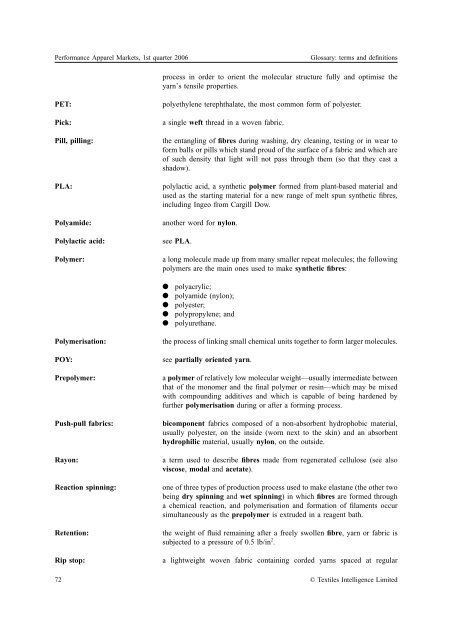Performance Apparel Markets - Grado Zero Espace Srl
Performance Apparel Markets - Grado Zero Espace Srl
Performance Apparel Markets - Grado Zero Espace Srl
You also want an ePaper? Increase the reach of your titles
YUMPU automatically turns print PDFs into web optimized ePapers that Google loves.
<strong>Performance</strong> <strong>Apparel</strong> <strong>Markets</strong>, 1st quarter 2006<br />
Glossary: terms and definitions<br />
process in order to orient the molecular structure fully and optimise the<br />
yarn’s tensile properties.<br />
PET:<br />
Pick:<br />
Pill, pilling:<br />
PLA:<br />
Polyamide:<br />
Polylactic acid:<br />
Polymer:<br />
polyethylene terephthalate, the most common form of polyester.<br />
a single weft thread in a woven fabric.<br />
the entangling of fibres during washing, dry cleaning, testing or in wear to<br />
form balls or pills which stand proud of the surface of a fabric and which are<br />
of such density that light will not pass through them (so that they cast a<br />
shadow).<br />
polylactic acid, a synthetic polymer formed from plant-based material and<br />
used as the starting material for a new range of melt spun synthetic fibres,<br />
including Ingeo from Cargill Dow.<br />
another word for nylon.<br />
see PLA.<br />
a long molecule made up from many smaller repeat molecules; the following<br />
polymers are the main ones used to make synthetic fibres:<br />
●<br />
●<br />
●<br />
●<br />
●<br />
polyacrylic;<br />
polyamide (nylon);<br />
polyester;<br />
polypropylene; and<br />
polyurethane.<br />
Polymerisation:<br />
POY:<br />
Prepolymer:<br />
Push-pull fabrics:<br />
Rayon:<br />
Reaction spinning:<br />
Retention:<br />
Rip stop:<br />
the process of linking small chemical units together to form larger molecules.<br />
see partially oriented yarn.<br />
a polymer of relatively low molecular weight—usually intermediate between<br />
that of the monomer and the final polymer or resin—which may be mixed<br />
with compounding additives and which is capable of being hardened by<br />
further polymerisation during or after a forming process.<br />
bicomponent fabrics composed of a non-absorbent hydrophobic material,<br />
usually polyester, on the inside (worn next to the skin) and an absorbent<br />
hydrophilic material, usually nylon, on the outside.<br />
a term used to describe fibres made from regenerated cellulose (see also<br />
viscose, modal and acetate).<br />
one of three types of production process used to make elastane (the other two<br />
being dry spinning and wet spinning) in which fibres are formed through<br />
a chemical reaction, and polymerisation and formation of filaments occur<br />
simultaneously as the prepolymer is extruded in a reagent bath.<br />
the weight of fluid remaining after a freely swollen fibre, yarn or fabric is<br />
subjected to a pressure of 0.5 lb/in 2 .<br />
a lightweight woven fabric containing corded yarns spaced at regular<br />
72 © Textiles Intelligence Limited
















